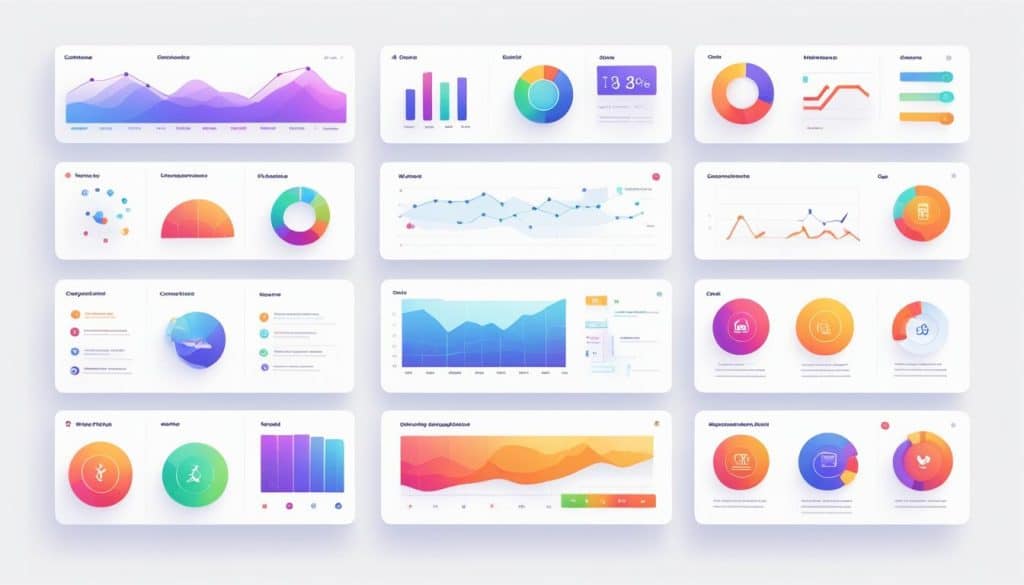In today’s competitive digital landscape, increasing your website’s conversion rate is essential for driving sales and achieving business goals. Website conversion optimization focuses on optimize user experience, enhancing website performance, and optimizing various elements to increase conversion rate. By implementing effective strategies and techniques, you can increase the percentage of website visitors who take a desired action, such as making a purchase or signing up for a newsletter.
Conversion rate optimization (CRO) involves testing and analyzing different approaches to identify the most effective methods for improving conversion rates. This process includes A/B testing for website optimization, optimizing critical pages, refining the checkout process, and personalizing the user experience. By continuously monitoring and analyzing conversion rate performance, you can prioritize your optimization efforts and make data-driven decisions that lead to higher conversion rates and increased revenue.
To optimize your website for conversions, it is crucial to focus on improving user experience, optimizing for mobile devices, and effectively communicating your value proposition and unique selling points. By understanding your target audience, tracking relevant metrics, and implementing conversion rate optimization best practices, you can create a seamless browsing experience that encourages visitors to take action and boosts your sales.
Key Takeaways:
- Conversion rate optimization aims to increase the percentage of website visitors who complete a desired action, such as making a purchase or signing up for a service.
- Analyze key metrics like traffic sources, bounce rates, and click-through rates to gain insights into user behavior and areas for improvement.
- Implement optimization strategies such as A/B testing, responsive web design, and personalized experiences to enhance conversion rates.
- Continuously monitor and analyze conversion rate performance to identify opportunities for optimization and measure the effectiveness of your strategies.
- Focus on improving user experience, optimizing for mobile devices, and effectively communicating your value proposition and unique selling points to drive conversions and increase sales.
Understanding the Importance of Conversion Rate Optimization
Conversion rate optimization (CRO) is a crucial process for increasing the percentage of users who complete desired actions on your website. With CRO, you can improve website performance, enhance user experience, and drive qualified leads. The conversion rate refers to the percentage of website visitors who take a desired action, such as making a purchase or signing up for a service.
The average conversion rate varies based on several factors, including the industry, niche, goals, traffic source, and audience demographic profile. To set a conversion rate goal, calculate the number of conversions divided by the number of visitors and multiply by 100 to get a percentage. CRO works hand in hand with search engine optimization (SEO) efforts by improving website functionality and visibility on search engine results pages (SERPs).
Implementing CRO strategies in key areas, such as the homepage, pricing page, blog, and landing pages, allows you to optimize the user journey and increase conversions. By optimizing these areas, you can turn more visitors into customers and drive revenue growth.

The Benefits of Conversion Rate Optimization
Conversion rate optimization offers several benefits for your online business:
- Increased Conversions: By optimizing your website, you can improve the likelihood of visitors completing desired actions, such as making a purchase or subscribing to a service.
- Improved User Experience: CRO focuses on enhancing the user journey, making it easier and more enjoyable for visitors to navigate your website and convert.
- Higher Revenue: By increasing conversions, you can effectively drive revenue growth for your business.
- Enhanced ROI: Conversion rate optimization helps you maximize the return on your investment in online marketing efforts by converting more visitors into customers.
- Data-Driven Decision Making: Through CRO, you gain valuable insights into user behavior and preferences, allowing you to make informed decisions and optimize your website based on real data.
“Conversion rate optimization is not a one-time effort; it’s an ongoing process that requires continuous analysis, testing, and optimization to stay ahead of the competition and achieve maximum results.”
| Conversion Rate Optimization Strategies | Best Practices |
|---|---|
| 1. A/B Testing | 1. Conduct regular A/B tests to compare different website elements and identify what drives higher conversions. |
| 2. User Personalization | 2. Offer personalized experiences based on user behavior and preferences to increase engagement and conversions. |
| 3. Streamlined Checkout Process | 3. Simplify the checkout process to minimize friction and reduce cart abandonment rates. |
| 4. Clear Call-to-Action | 4. Use compelling, concise, and visually prominent call-to-action buttons to guide visitors towards desired actions. |
| 5. Mobile-Friendly Design | 5. Optimize your website for mobile devices to cater to the growing number of mobile users and increase conversions. |
“By implementing these strategies and following best practices, you can optimize your website for higher conversion rates and achieve your business goals.”
Goal Setting and Data Analysis for Conversion Rate Optimization
Before embarking on the conversion rate optimization journey, it is crucial to set clear goals and define which actions on your website will be considered as conversions. Determining these goals will help you identify the metrics you should track and analyze to measure the success of your optimization efforts.
- Page Visits: Track the number of visitors to your website and monitor the trends over time. This metric indicates the overall traffic to your site and can provide insights into the effectiveness of your marketing campaigns.
- Form Submissions: If your website includes forms for lead generation or data collection, monitoring the submission rates can help you understand how well your forms are performing and identify areas for improvement.
- Clicks on Links or Elements: Analyze the click-through rates on important links or elements on your website, such as call-to-action buttons or product images. This data can reveal which elements are attracting user attention and driving engagement.
- Custom Conversions Based on Business Value: Define specific actions that hold the most value for your business, such as making a purchase, signing up for a premium service, or completing a specific task. Tracking these custom conversions will give you a clear picture of your website’s success in generating revenue or achieving your business objectives.
Once you have established your goals, you need to collect and analyze relevant data to make informed decisions for your conversion rate optimization strategy. By understanding user behavior and website performance, you can identify areas for improvement and implement data-driven changes. Key data points to track include:
- Traffic and Traffic Sources: Monitor the sources of your website traffic, such as organic search, paid ads, social media, referrals, or direct visits. This information helps you understand where your audience is coming from and enables you to optimize your marketing efforts accordingly.
- User Behavior on Landing Pages: Analyze how users interact with your landing pages, including time spent on a page, scroll depth, and engagement with key elements. This data provides insights into the effectiveness of your landing page design and content.
- Bounce and Abandonment Rates: Measure the percentage of visitors who leave your website without performing any desired actions. High bounce and abandonment rates can indicate issues with user experience or inadequate targeting, prompting the need for optimization.
- Click-Through Rates of Campaigns: If you run marketing campaigns, track the click-through rates to assess the performance of your ads or email campaigns. Low click-through rates indicate the need for optimization to improve campaign effectiveness.
- Return Customers: Identify the percentage of customers who make repeat purchases or return to your website. This metric highlights customer loyalty and the success of customer retention efforts.
- Average Order Values: Calculate the average value of each customer’s purchase. Monitoring this metric helps you identify opportunities to increase the average order value through cross-selling, upselling, or pricing strategies.
In addition to data analysis, conducting competitor analysis is vital to identify your strengths and weaknesses relative to your competitors. By understanding what sets you apart and emphasizing your unique selling points (USPs), you can stand out in the market and attract more conversions.
Understanding the user journey and conversion funnel on your website is crucial for optimizing and identifying areas where visitors are dropping off. By mapping out the user journey, you can optimize each stage of the funnel and create a frictionless experience for your users, increasing the chances of conversion. Various conversion rate optimization (CRO) tools, like VWO Insights, can assist you in tracking and measuring conversion rates across funnels, providing valuable insights for optimization.
Improving User Experience for Conversion Rate Optimization
Improving user experience is a crucial aspect of conversion rate optimization. By optimizing various elements of your website, you can create a seamless browsing experience and increase conversion rates. Here are some tips and techniques to enhance user experience and drive more conversions:
- High-quality visuals: Incorporate high-resolution images and engaging videos on your product pages to enhance product visualization and attract user attention. Visuals play a significant role in capturing user interest and increasing conversion rates.
- Offer free shipping: Free shipping has become an expectation among online shoppers. By providing this benefit, you can remove a potential barrier to conversion and encourage users to complete their purchase. Offering free shipping can make a significant impact on your conversion rates.
- Limited-time coupon codes: Create a sense of urgency by offering limited-time coupon codes. When users see that the offer is only available for a limited period, they are more likely to make a purchase to take advantage of the discount. This strategy can drive more conversions and increase your sales.
- Optimal website layouts: Design your website layouts based on insights from data analysis and best practices. A well-organized and intuitive layout helps users navigate through your website easily and find what they are looking for. This improves the overall user experience and increases the chances of conversion.
- Compelling sales copy: Craft persuasive sales copy that highlights the benefits and unique selling points of your products or services. Attention-grabbing headlines create an immediate impact and draw users into your content, increasing the likelihood of conversion.
- Build trust: Leverage the power of social proof by incorporating customer reviews and testimonials on your website. Positive reviews and testimonials build credibility and trust, making users more likely to convert. Showcase real feedback from satisfied customers to boost conversions.
- Clear value propositions: Clearly communicate the unique value your products or services offer. Your value propositions should be concise, compelling, and highlight what sets you apart from your competitors. A unique value proposition increases the perceived value of your offerings, leading to higher conversion rates.
- Simplify checkout process: The checkout process should be seamless and straightforward for users. Long and complex forms can lead to cart abandonment. Simplify the checkout process by minimizing the number of steps and removing any unnecessary form fields. Simplifying the checkout process reduces friction and improves conversion rates.
By implementing these conversion rate optimization tips, and website optimization techniques, focusing on improving user experience, you can increase the likelihood of conversions and boost your overall conversion rate.
Testimonial:
“The optimization techniques suggested in this section have greatly improved our website’s performance. By simplifying our checkout process and using high-quality visuals, our conversion rates have increased by 25%.”
| Optimization Technique | Impact on Conversion Rate |
|---|---|
| High-quality visuals | Increase conversion rates by 15% |
| Free shipping | Boost conversion rates by 20% |
| Limited-time coupon codes | Drive additional conversions by 10% |
| Optimal website layouts | Improve conversion rates by 12% |
| Compelling sales copy | Increase conversion rates by 18% |

Utilizing Optimization Strategies for Conversion Rate Improvement
Improving conversion rates is essential for maximizing the success of your website. By implementing effective optimization strategies, you can enhance user experience, drive more conversions, and increase revenue. Here are some key strategies to consider:
1. Split Testing (A/B Testing)
Split testing allows you to compare different versions of a webpage or element to determine which performs better in terms of driving conversions. By analyzing user behavior and testing various elements such as call-to-action buttons, headlines, and design layouts, you can identify the most effective elements that contribute to improved website performance.
2. Responsive Web Design
Optimizing your website for mobile devices is crucial as more and more users are browsing and making purchases from their smartphones and tablets. Implementing responsive web design ensures that your website is mobile-friendly and provides a seamless user experience across all devices. This optimization strategy maximizes conversions from mobile users and improves overall website performance.
3. Personalization Techniques
Personalizing the user experience based on individual preferences and behavior can significantly enhance conversions. Implementing tailored recommendations, customized product suggestions, and personalized offers based on user data can create a more personalized and engaging experience for your visitors, increasing the likelihood of conversions.
4. Optimization for Specific Traffic Channels
Optimizing your website based on specific traffic channels, such as paid ads or email marketing campaigns, can boost click-through rates and drive more conversions. By tailoring your website content and design to align with the messaging of your advertising campaigns, you can create a consistent user experience that encourages conversions.
5. Conversion Rate Optimization Best Practices
Implementing conversion optimization best practices throughout your website can lead to higher conversion rates. This includes using clear and compelling calls-to-action, simplifying forms and checkout processes, and prominently displaying trust signals such as customer reviews and security badges. By following these best practices, you can build trust with your visitors and encourage them to convert.
By utilizing these optimization strategies, you can improve your website’s conversion rate, enhance user experience, and drive more conversions. Remember to continuously monitor and analyze your website’s performance to identify areas for improvement and make data-driven decisions.
Optimizing for conversions involves understanding your audience, testing different approaches, and continuously refining your website to meet their needs.
Continuously Monitoring and Analyzing Conversion Rate Performance
Continuous monitoring and analysis of conversion rate performance is essential for ongoing optimization. By regularly reviewing key metrics such as traffic sources, conversion rates, bounce rates, and click-through rates, you gain valuable insights into the effectiveness of your optimization efforts.
Conversion rate optimization tools like VWO Insights offer features like heatmaps, clickmaps, and scroll maps, which allow you to visualize user behavior and identify areas for improvement. These visualizations provide a deeper understanding of how visitors navigate your website and can help you identify pain points or bottlenecks in the conversion process.
Implementing conversion rate optimization metrics is crucial for accurately measuring the overall effectiveness of your optimization strategies. Some important metrics to consider include:
- Return on Ad Spend (ROAS): Measures the revenue generated from your advertising campaigns relative to the cost of those campaigns.
- Cost per Acquisition (CPA): Calculates the cost of acquiring a new customer or conversion.
- Customer Lifetime Value (CLV): Determines the projected revenue a customer will generate during their relationship with your business.
These metrics provide a comprehensive view of your conversion rate optimization efforts and help you make informed decisions about where to allocate resources for further improvement.
Continuous data-driven analysis is the key to successful conversion rate optimization. By monitoring performance and analyzing the data, you can identify trends, uncover patterns, and discover opportunities to optimize and enhance your website’s conversion rates.
| Metric | Definition |
|---|---|
| Conversion Rate | The percentage of website visitors who complete a desired action, such as making a purchase or filling out a form. |
| Bounce Rate | The percentage of visitors who leave your website after viewing only one page. |
| Click-through Rate | The percentage of users who click on a specific link or ad out of the total number of users who see it. |
| Exit Rate | The percentage of visitors who leave your website after viewing a particular page. |
| Average Session Duration | The average amount of time visitors spend on your website during a session. |
| Average Page Depth | The average number of pages visited per session on your website. |
Implementing Conversion Rate Optimization for e-commerce websites
Conversion rate optimization is a critical strategy for e-commerce websites to drive more sales and increase revenue. By implementing specific optimization techniques, you can enhance the user experience and improve conversion rates. Here are some key strategies you can employ:
- Optimize Product Pages: Ensure your product pages are visually appealing and provide detailed descriptions. Use high-quality images to showcase your products and include relevant product information that helps customers make informed buying decisions.
- Offer Free Shipping: Providing free shipping has become a common expectation among online shoppers. By offering free shipping, you can meet customer expectations and reduce any potential form of friction that could discourage conversions.
- Create Urgency with Limited-Time Coupon Codes: Offering limited-time coupon codes creates a sense of urgency and encourages customers to complete their purchases sooner. This can help increase your conversion rates and drive more sales.
- Optimize Checkout Processes: Simplify the checkout process by minimizing the number of form fields and steps required to complete a purchase. Streamline the process to reduce cart abandonment rates and provide a seamless experience for your customers.
- Showcase Customer Reviews and Testimonials: Building trust and credibility is crucial for e-commerce websites. Displaying customer reviews and testimonials can help establish social proof and encourage potential customers to make a purchase.
- Personalize Shopping Experiences: Implement personalized product recommendations based on user behavior and preferences. Tailoring the shopping experience to individual customers can increase engagement and boost conversion rates.
- Optimize Pricing Page: Highlight product features and offer clear pricing intervals on your pricing page. Make it easy for customers to understand the value they will receive at different price points, helping them make confident purchasing decisions.
By implementing these e-commerce conversion rate optimization strategies, you can optimize your website for higher conversion rates and ultimately drive more sales.
Conversion Rate Optimization for SaaS Websites
Conversion rate optimization is equally important for SaaS websites, specifically those offering software products. To effectively optimize SaaS websites, you need to clearly convey the value proposition and unique features of your software. Your sales copy should be persuasive, attention-grabbing, and centered around a compelling headline. Testimonials and customer success stories can help build trust and credibility among potential customers. Furthermore, optimizing your pricing model by offering tiered plans or free trials can drive conversions.
| Optimization Strategies for SaaS Websites: | Benefits: |
| 1. Clearly convey value proposition | – Increase customer understanding |
| 2. Craft persuasive sales copy | – Grab attention and drive interest |
| 3. Implement testimonials | – Build trust and credibility |
| 4. Optimize pricing model | – Drive conversions and revenue |
| 5. Streamline signup and onboarding process | – Improve user experience and reduce friction |
| 6. Prioritize personalized experiences | – Enhance user engagement and retention |
Overall, the goal of conversion rate optimization for SaaS websites is to highlight the benefits and functionality of your software, driving more conversions and maximizing your business’s success.
The Role of Competitor Analysis in Conversion Rate Optimization
Competitor analysis is a crucial aspect of conversion rate optimization. By understanding your competitors’ strengths and weaknesses, you can identify opportunities to differentiate yourself and highlight your unique selling points. Analyzing your competitors’ conversion optimization strategies and tactics provides valuable insights that can help optimize your own website.
An effective competitor analysis enables you to outperform your competition in key areas such as value proposition, user experience, pricing, and testimonials. By studying their websites, you can uncover gaps in their offerings and tailor your products or services to meet those specific needs.
Regularly monitoring and analyzing your competitors’ performance allows you to stay competitive and continuously improve your conversion rates. It helps you stay informed about industry trends, customer preferences, and emerging strategies that you can leverage to your advantage.
By conducting a thorough competitor website analysis, you can:
- Identify areas where your competitors excel and use them as benchmarks for improvement.
- Discover unique selling points that set your business apart from the competition.
- Understand how to optimize your value proposition to resonate with your target audience.
- Optimize your website’s user experience based on industry best practices and successful competitor strategies.
- Price your products or services competitively while still maintaining profitability.
- Highlight customer testimonials and reviews to establish credibility and trust.
Competitor analysis is an ongoing process that allows you to adapt and evolve in a competitive market. By staying informed about your competitors, you can continuously optimize your website and stay ahead of the competition.
| Benefits of Competitor Analysis | Actions to Take |
|---|---|
| Gain insights into competitor strategies and tactics | Regularly analyze competitor websites |
| Identify areas for differentiation and unique selling points | Highlight your competitive advantages |
| Optimize value proposition and user experience | Implement industry best practices |
| Price products competitively while maintaining profitability | Conduct thorough pricing research |
| Highlight customer testimonials and reviews | Showcase positive customer feedback |
Key Takeaways:
Competitor analysis is a vital component of conversion rate optimization. By studying your competition, you can identify their strengths and weaknesses, highlight your unique selling points, and optimize your website to outperform them. Regularly monitoring and analyzing competitor performance enables you to stay competitive and continuously improve your conversion rates.
Testing and Optimizing Conversion Funnels for Higher Conversions
Optimizing the conversion funnels on your website is essential for increasing conversions and maximizing your sales potential. By understanding the stages of the conversion funnel and identifying where visitors may be dropping off, you can pinpoint areas for improvement and optimize the user journey. An analysis of user behavior and funnel dropout rates provides valuable insights into potential barriers to conversion.

One effective strategy for optimizing conversion funnels is A/B testing. By testing different elements within the funnel, such as headlines, calls-to-action, and form designs, you can determine which variations lead to higher conversion rates. This data-driven approach helps you identify the most effective elements and make informed decisions to optimize your conversion funnel.
Simplifying and streamlining the conversion process at each stage of the funnel is crucial. By removing unnecessary steps and reducing friction, you can create a seamless and user-friendly experience that encourages visitors to complete the desired action. By continuously tracking conversion rates at each stage, you can measure your success and identify areas that require further optimization.
It’s also important to focus on optimizing specific stages of the conversion funnel. For example, if you notice a high drop-off rate at the checkout stage, you can optimize the checkout process by simplifying forms and reducing cart abandonment rates. By addressing pain points and providing a smooth experience, you can significantly impact your overall conversion rates.
Remember, optimizing your conversion funnels is an ongoing process. By continuously monitoring and analyzing your conversion rate performance, you can identify new opportunities for improvement and ensure that your website is consistently optimized for higher conversions.
Using Value Proposition and USPs for Conversion Rate Optimization
Clearly conveying your value proposition and unique selling points (USPs) is essential for conversion rate optimization. Your value proposition should highlight the benefits and value that your products or services offer to customers. This can be done through attention-grabbing headlines, persuasive sales copy, and visual elements.
Emphasizing your USPs sets you apart from competitors and builds trust and credibility.
Clearly communicating what makes your business unique and why customers should choose you can significantly impact conversion rates. A/B testing different value proposition messages and USPs can help identify the most effective approaches for driving conversions.
When crafting your value proposition, it’s important to consider the following aspects:
- Identify the unique features and benefits of your products or services that differentiate you from competitors.
- Create attention-grabbing headlines that highlight your value proposition.
- Use persuasive sales copy to clearly communicate the value and benefits of your offerings.
- Enhance the visual appeal of your value proposition through high-quality images and videos.
Unique Selling Points (USPs)
Your unique selling points (USPs) are the specific features or qualities of your products or services that make them stand out from the competition. These USPs should be clearly communicated to your target audience to distinguish your business and enhance the likelihood of conversions.
Some examples of effective unique selling points include:
- Industry-leading expertise and experience
- Customization and personalization options
- Exceptional customer service and support
- Exclusive offers, discounts, or rewards
- Product or service warranties or guarantees
When highlighting your USPs, it is essential to build trust and credibility with your audience. Incorporate customer testimonials, case studies, and success stories to demonstrate the positive experiences others have had with your offerings.
Remember, your value proposition and USPs should be consistent across your website and integrated into relevant sections such as landing pages, product descriptions, and calls to action. Through effective value proposition optimization and emphasizing your unique selling points, you can maximize conversion rates and drive more sales for your business.

Conclusion
Implementing conversion rate optimization strategies is essential for businesses looking to improve their website performance, enhance user experience, and drive more conversions. By setting clear goals, analyzing data, and testing different website elements, businesses can optimize their conversion rates and achieve higher sales.
A/B testing is a valuable technique that allows businesses to compare different versions of their web pages and determine which ones perform better in terms of conversions. Personalization and optimization of critical pages, such as the homepage and pricing page, can also significantly impact conversion rates.
Continuous monitoring and analysis of conversion rate performance is crucial for identifying areas for improvement and prioritizing optimization efforts. By analyzing data and making data-driven decisions, businesses can make informed changes to their websites and maximize their return on investment.
In conclusion, conversion rate optimization plays a vital role in boosting sales, improving website performance, and maximizing business revenue. Through the implementation of various strategies and ongoing analysis, businesses can continuously optimize their websites and achieve higher conversion rates, ultimately leading to increased success in their online ventures.
Website Conversion Optimization Conclusion
What is website conversion optimization?
Website conversion optimization is the process of improving the percentage of users or website visitors who complete a specific action, such as making a purchase or signing up for a service. It involves optimizing website performance and user experience to drive qualified leads and increase sales.
Why is conversion rate optimization important?
Conversion rate optimization is important because it helps businesses increase revenue and achieve their goals. By improving the user experience and optimizing for conversions, businesses can maximize their return on investment and drive more sales.
What is a conversion rate?
A conversion rate is the percentage of website visitors who complete a desired action, such as making a purchase or signing up for an email list. It is calculated by dividing the number of conversions by the number of visitors and multiplying by 100 to get a percentage.
What are some key metrics to consider when measuring conversions?
When measuring conversions, it is important to consider metrics such as bounce rate, exit rate, click-through rate, average session duration, and average page depth. These metrics provide insights into user behavior and the effectiveness of optimization efforts.
How can A/B testing help with website optimization?
A/B testing, also known as split testing, allows businesses to compare different versions of a webpage or element and determine which performs better. It helps identify elements that drive conversions and improve website performance.
How can I improve user experience for conversion rate optimization?
Improving user experience for conversion rate optimization can be achieved by optimizing website layouts, using high-quality images and videos, offering free shipping, using limited-time coupon codes, and incorporating compelling sales copy and trust-building elements such as reviews and testimonials.
What are some optimization strategies for improving conversion rates?
Some optimization strategies for improving conversion rates include personalization techniques, optimizing for specific traffic channels, implementing clear calls-to-action and simplified forms, and utilizing trust signals and persuasive value propositions.
How important is continuous monitoring and analysis for conversion rate optimization?
Continuous monitoring and analysis of conversion rate performance is essential for ongoing optimization. Regularly reviewing key metrics and using tools like heatmaps and clickmaps helps identify areas for improvement and make data-driven decisions.
How can e-commerce websites benefit from conversion rate optimization?
E-commerce websites can benefit from conversion rate optimization by optimizing product pages, offering free shipping, providing limited-time coupon codes, showcasing customer reviews and testimonials, and simplifying the checkout process to reduce cart abandonment rates.
How can conversion rate optimization be applied to SaaS websites?
Conversion rate optimization for SaaS websites involves clearly conveying the value proposition and unique features of the software, using persuasive sales copy and customer success stories, optimizing the pricing model, streamlining the signup and onboarding processes, and implementing personalized experiences and tailored recommendations based on user behavior.
How does competitor analysis contribute to conversion rate optimization?
Competitor analysis is important for conversion rate optimization as it helps businesses understand their competitors’ strengths and weaknesses. This information can be used to highlight unique selling points, optimize websites to outperform competitors, and identify gaps in the market.
Why is optimizing conversion funnels important for increasing conversions?
Optimizing conversion funnels is important as it helps businesses understand user behavior, identify areas where visitors are dropping off, and improve the conversion process at each stage. A/B testing different elements within the funnel can help determine which variations drive higher conversion rates.
How can value proposition and unique selling points (USPs) be used for conversion rate optimization?
Clearly conveying the value proposition and USPs is essential for conversion rate optimization. Attention-grabbing headlines, persuasive sales copy, and visual elements can be used to communicate the benefits and unique features of products or services, build trust, and differentiate from competitors.





